Report on Business Environment Analysis: Tesco, Sainsbury's, Iceland
VerifiedAdded on 2023/01/16
|13
|4466
|43
Report
AI Summary
This report provides a comprehensive analysis of the business environment, focusing on the organizational structures, functions, and market positions of Tesco, Sainsbury's, and Iceland. It explores the types and purposes of organizations, including private, public, and voluntary sectors, using these three UK-based companies as examples. The report delves into the size and scope of each organization, examining their market share, employee numbers, and expansion strategies. It also investigates the interrelationships between various organizational functions, such as human resources, top-level management, marketing, and finance. Furthermore, the report analyzes the macro environment of the business, considering factors such as political, economic, technological, legal, and environmental influences. Internal and external analyses of the specific organizations are conducted, evaluating strengths, weaknesses, and how they interrelate with external factors. The conclusion summarizes the key findings and the impact of the business environment on organizational performance and strategic planning.
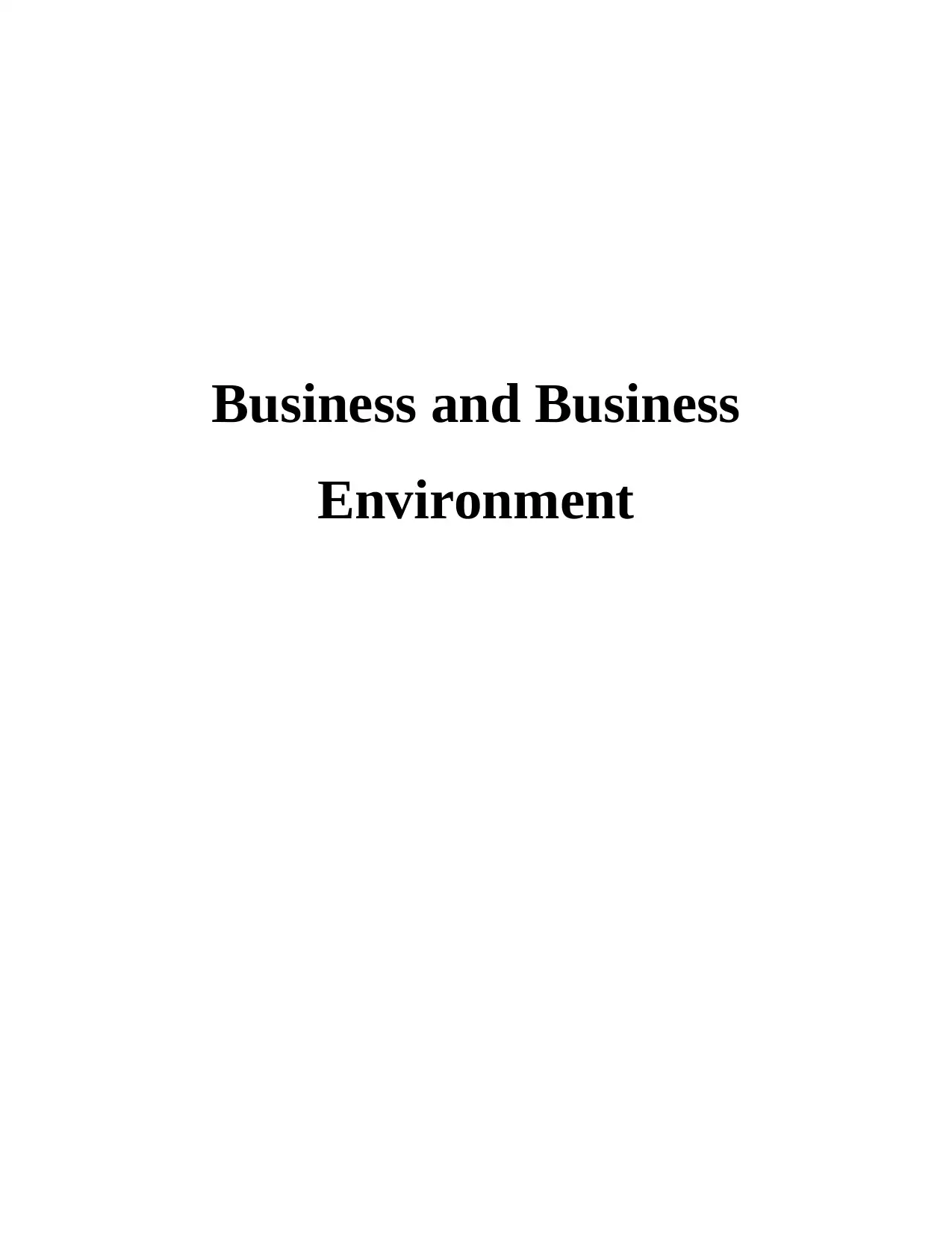
Business and Business
Environment
Environment
Paraphrase This Document
Need a fresh take? Get an instant paraphrase of this document with our AI Paraphraser
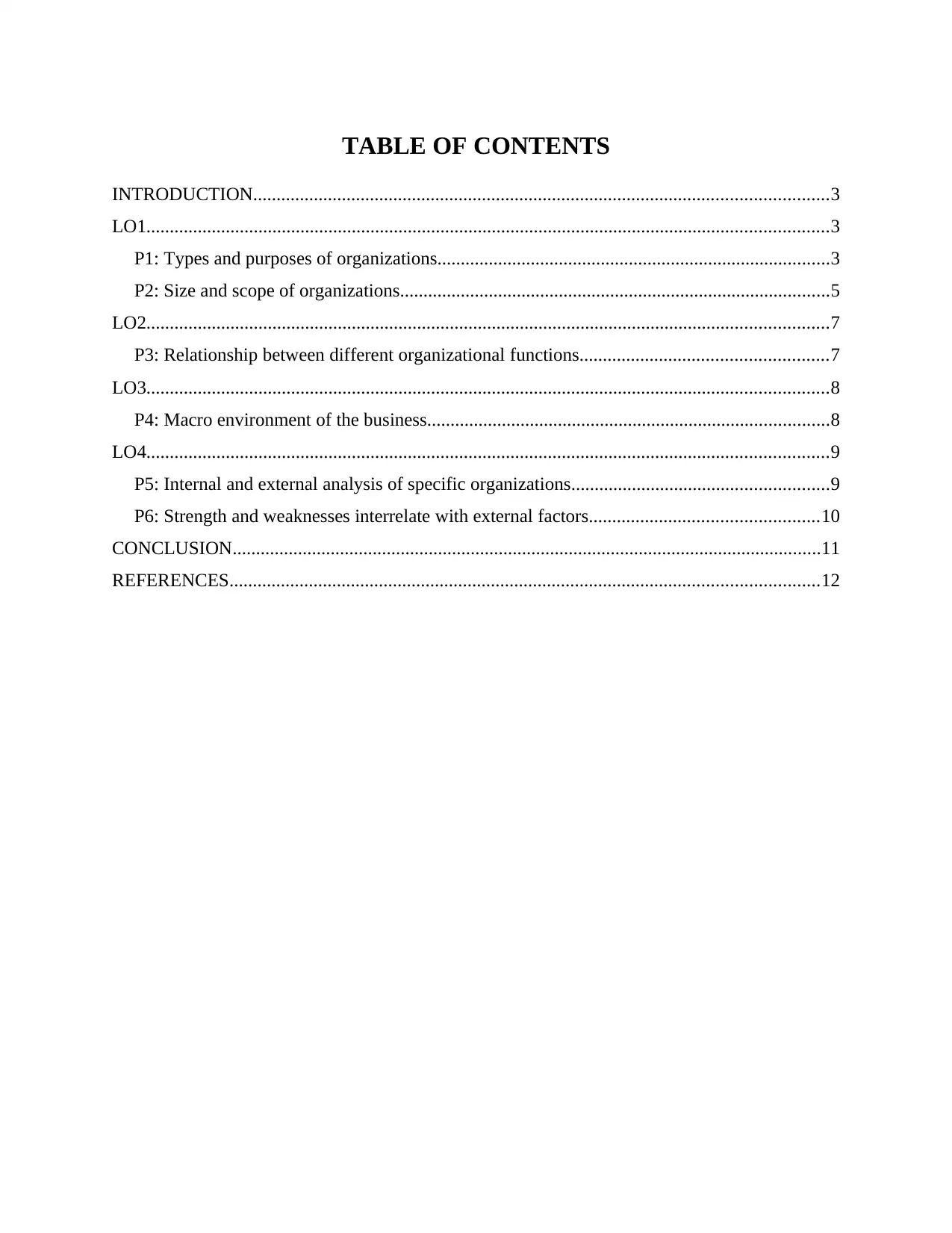
TABLE OF CONTENTS
INTRODUCTION...........................................................................................................................3
LO1..................................................................................................................................................3
P1: Types and purposes of organizations....................................................................................3
P2: Size and scope of organizations............................................................................................5
LO2..................................................................................................................................................7
P3: Relationship between different organizational functions.....................................................7
LO3..................................................................................................................................................8
P4: Macro environment of the business......................................................................................8
LO4..................................................................................................................................................9
P5: Internal and external analysis of specific organizations.......................................................9
P6: Strength and weaknesses interrelate with external factors.................................................10
CONCLUSION..............................................................................................................................11
REFERENCES..............................................................................................................................12
INTRODUCTION...........................................................................................................................3
LO1..................................................................................................................................................3
P1: Types and purposes of organizations....................................................................................3
P2: Size and scope of organizations............................................................................................5
LO2..................................................................................................................................................7
P3: Relationship between different organizational functions.....................................................7
LO3..................................................................................................................................................8
P4: Macro environment of the business......................................................................................8
LO4..................................................................................................................................................9
P5: Internal and external analysis of specific organizations.......................................................9
P6: Strength and weaknesses interrelate with external factors.................................................10
CONCLUSION..............................................................................................................................11
REFERENCES..............................................................................................................................12
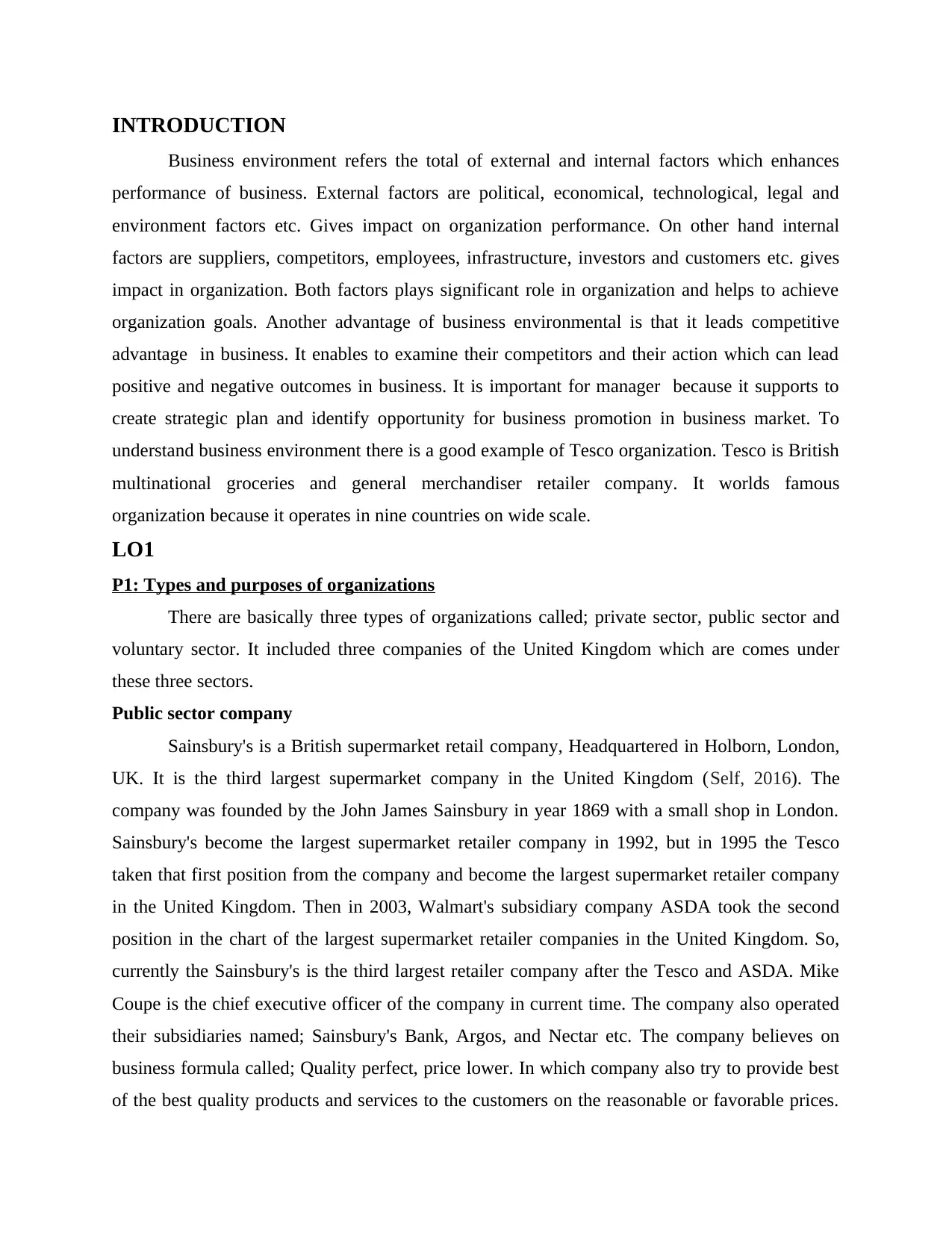
INTRODUCTION
Business environment refers the total of external and internal factors which enhances
performance of business. External factors are political, economical, technological, legal and
environment factors etc. Gives impact on organization performance. On other hand internal
factors are suppliers, competitors, employees, infrastructure, investors and customers etc. gives
impact in organization. Both factors plays significant role in organization and helps to achieve
organization goals. Another advantage of business environmental is that it leads competitive
advantage in business. It enables to examine their competitors and their action which can lead
positive and negative outcomes in business. It is important for manager because it supports to
create strategic plan and identify opportunity for business promotion in business market. To
understand business environment there is a good example of Tesco organization. Tesco is British
multinational groceries and general merchandiser retailer company. It worlds famous
organization because it operates in nine countries on wide scale.
LO1
P1: Types and purposes of organizations
There are basically three types of organizations called; private sector, public sector and
voluntary sector. It included three companies of the United Kingdom which are comes under
these three sectors.
Public sector company
Sainsbury's is a British supermarket retail company, Headquartered in Holborn, London,
UK. It is the third largest supermarket company in the United Kingdom (Self, 2016). The
company was founded by the John James Sainsbury in year 1869 with a small shop in London.
Sainsbury's become the largest supermarket retailer company in 1992, but in 1995 the Tesco
taken that first position from the company and become the largest supermarket retailer company
in the United Kingdom. Then in 2003, Walmart's subsidiary company ASDA took the second
position in the chart of the largest supermarket retailer companies in the United Kingdom. So,
currently the Sainsbury's is the third largest retailer company after the Tesco and ASDA. Mike
Coupe is the chief executive officer of the company in current time. The company also operated
their subsidiaries named; Sainsbury's Bank, Argos, and Nectar etc. The company believes on
business formula called; Quality perfect, price lower. In which company also try to provide best
of the best quality products and services to the customers on the reasonable or favorable prices.
Business environment refers the total of external and internal factors which enhances
performance of business. External factors are political, economical, technological, legal and
environment factors etc. Gives impact on organization performance. On other hand internal
factors are suppliers, competitors, employees, infrastructure, investors and customers etc. gives
impact in organization. Both factors plays significant role in organization and helps to achieve
organization goals. Another advantage of business environmental is that it leads competitive
advantage in business. It enables to examine their competitors and their action which can lead
positive and negative outcomes in business. It is important for manager because it supports to
create strategic plan and identify opportunity for business promotion in business market. To
understand business environment there is a good example of Tesco organization. Tesco is British
multinational groceries and general merchandiser retailer company. It worlds famous
organization because it operates in nine countries on wide scale.
LO1
P1: Types and purposes of organizations
There are basically three types of organizations called; private sector, public sector and
voluntary sector. It included three companies of the United Kingdom which are comes under
these three sectors.
Public sector company
Sainsbury's is a British supermarket retail company, Headquartered in Holborn, London,
UK. It is the third largest supermarket company in the United Kingdom (Self, 2016). The
company was founded by the John James Sainsbury in year 1869 with a small shop in London.
Sainsbury's become the largest supermarket retailer company in 1992, but in 1995 the Tesco
taken that first position from the company and become the largest supermarket retailer company
in the United Kingdom. Then in 2003, Walmart's subsidiary company ASDA took the second
position in the chart of the largest supermarket retailer companies in the United Kingdom. So,
currently the Sainsbury's is the third largest retailer company after the Tesco and ASDA. Mike
Coupe is the chief executive officer of the company in current time. The company also operated
their subsidiaries named; Sainsbury's Bank, Argos, and Nectar etc. The company believes on
business formula called; Quality perfect, price lower. In which company also try to provide best
of the best quality products and services to the customers on the reasonable or favorable prices.
⊘ This is a preview!⊘
Do you want full access?
Subscribe today to unlock all pages.

Trusted by 1+ million students worldwide
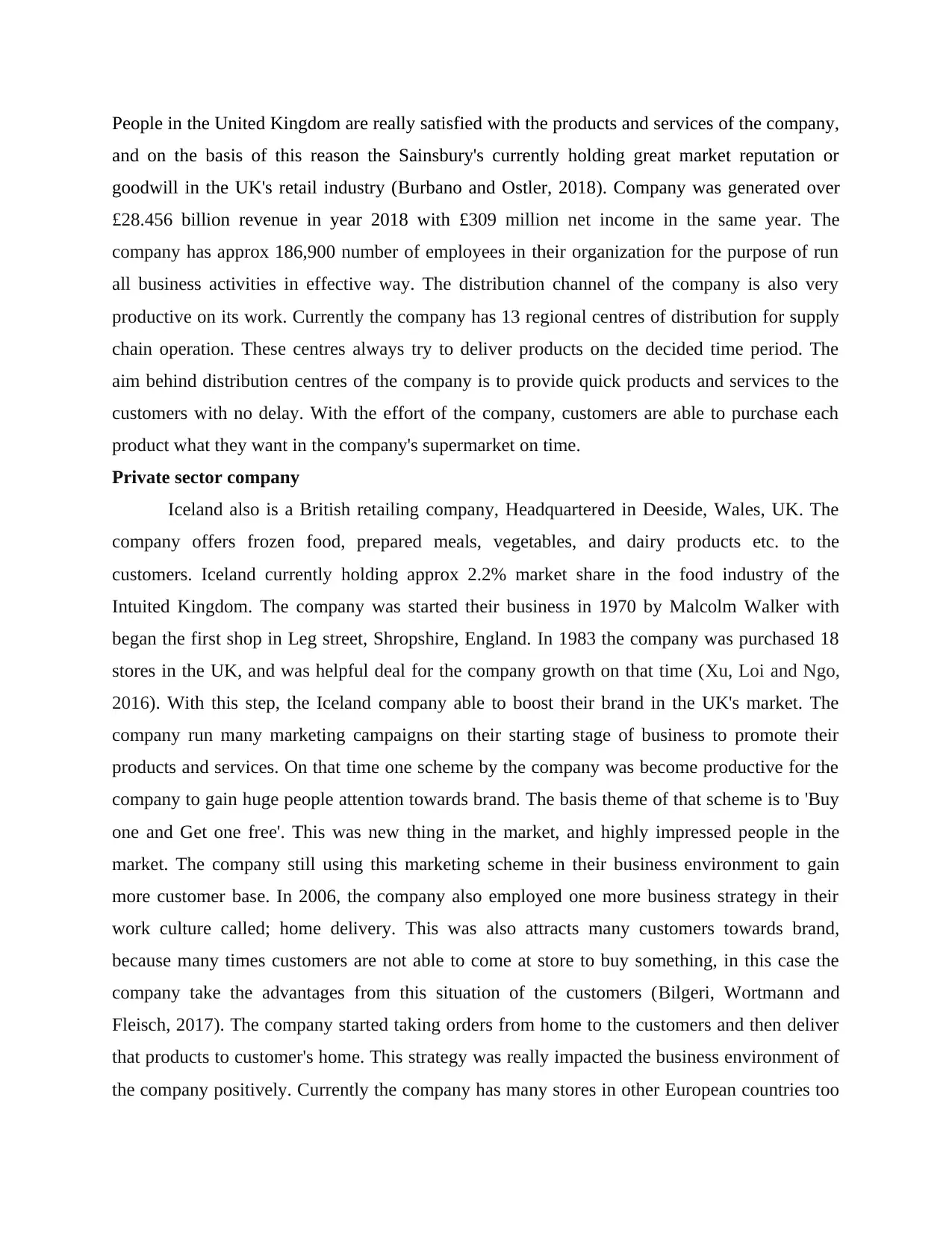
People in the United Kingdom are really satisfied with the products and services of the company,
and on the basis of this reason the Sainsbury's currently holding great market reputation or
goodwill in the UK's retail industry (Burbano and Ostler, 2018). Company was generated over
£28.456 billion revenue in year 2018 with £309 million net income in the same year. The
company has approx 186,900 number of employees in their organization for the purpose of run
all business activities in effective way. The distribution channel of the company is also very
productive on its work. Currently the company has 13 regional centres of distribution for supply
chain operation. These centres always try to deliver products on the decided time period. The
aim behind distribution centres of the company is to provide quick products and services to the
customers with no delay. With the effort of the company, customers are able to purchase each
product what they want in the company's supermarket on time.
Private sector company
Iceland also is a British retailing company, Headquartered in Deeside, Wales, UK. The
company offers frozen food, prepared meals, vegetables, and dairy products etc. to the
customers. Iceland currently holding approx 2.2% market share in the food industry of the
Intuited Kingdom. The company was started their business in 1970 by Malcolm Walker with
began the first shop in Leg street, Shropshire, England. In 1983 the company was purchased 18
stores in the UK, and was helpful deal for the company growth on that time (Xu, Loi and Ngo,
2016). With this step, the Iceland company able to boost their brand in the UK's market. The
company run many marketing campaigns on their starting stage of business to promote their
products and services. On that time one scheme by the company was become productive for the
company to gain huge people attention towards brand. The basis theme of that scheme is to 'Buy
one and Get one free'. This was new thing in the market, and highly impressed people in the
market. The company still using this marketing scheme in their business environment to gain
more customer base. In 2006, the company also employed one more business strategy in their
work culture called; home delivery. This was also attracts many customers towards brand,
because many times customers are not able to come at store to buy something, in this case the
company take the advantages from this situation of the customers (Bilgeri, Wortmann and
Fleisch, 2017). The company started taking orders from home to the customers and then deliver
that products to customer's home. This strategy was really impacted the business environment of
the company positively. Currently the company has many stores in other European countries too
and on the basis of this reason the Sainsbury's currently holding great market reputation or
goodwill in the UK's retail industry (Burbano and Ostler, 2018). Company was generated over
£28.456 billion revenue in year 2018 with £309 million net income in the same year. The
company has approx 186,900 number of employees in their organization for the purpose of run
all business activities in effective way. The distribution channel of the company is also very
productive on its work. Currently the company has 13 regional centres of distribution for supply
chain operation. These centres always try to deliver products on the decided time period. The
aim behind distribution centres of the company is to provide quick products and services to the
customers with no delay. With the effort of the company, customers are able to purchase each
product what they want in the company's supermarket on time.
Private sector company
Iceland also is a British retailing company, Headquartered in Deeside, Wales, UK. The
company offers frozen food, prepared meals, vegetables, and dairy products etc. to the
customers. Iceland currently holding approx 2.2% market share in the food industry of the
Intuited Kingdom. The company was started their business in 1970 by Malcolm Walker with
began the first shop in Leg street, Shropshire, England. In 1983 the company was purchased 18
stores in the UK, and was helpful deal for the company growth on that time (Xu, Loi and Ngo,
2016). With this step, the Iceland company able to boost their brand in the UK's market. The
company run many marketing campaigns on their starting stage of business to promote their
products and services. On that time one scheme by the company was become productive for the
company to gain huge people attention towards brand. The basis theme of that scheme is to 'Buy
one and Get one free'. This was new thing in the market, and highly impressed people in the
market. The company still using this marketing scheme in their business environment to gain
more customer base. In 2006, the company also employed one more business strategy in their
work culture called; home delivery. This was also attracts many customers towards brand,
because many times customers are not able to come at store to buy something, in this case the
company take the advantages from this situation of the customers (Bilgeri, Wortmann and
Fleisch, 2017). The company started taking orders from home to the customers and then deliver
that products to customer's home. This strategy was really impacted the business environment of
the company positively. Currently the company has many stores in other European countries too
Paraphrase This Document
Need a fresh take? Get an instant paraphrase of this document with our AI Paraphraser
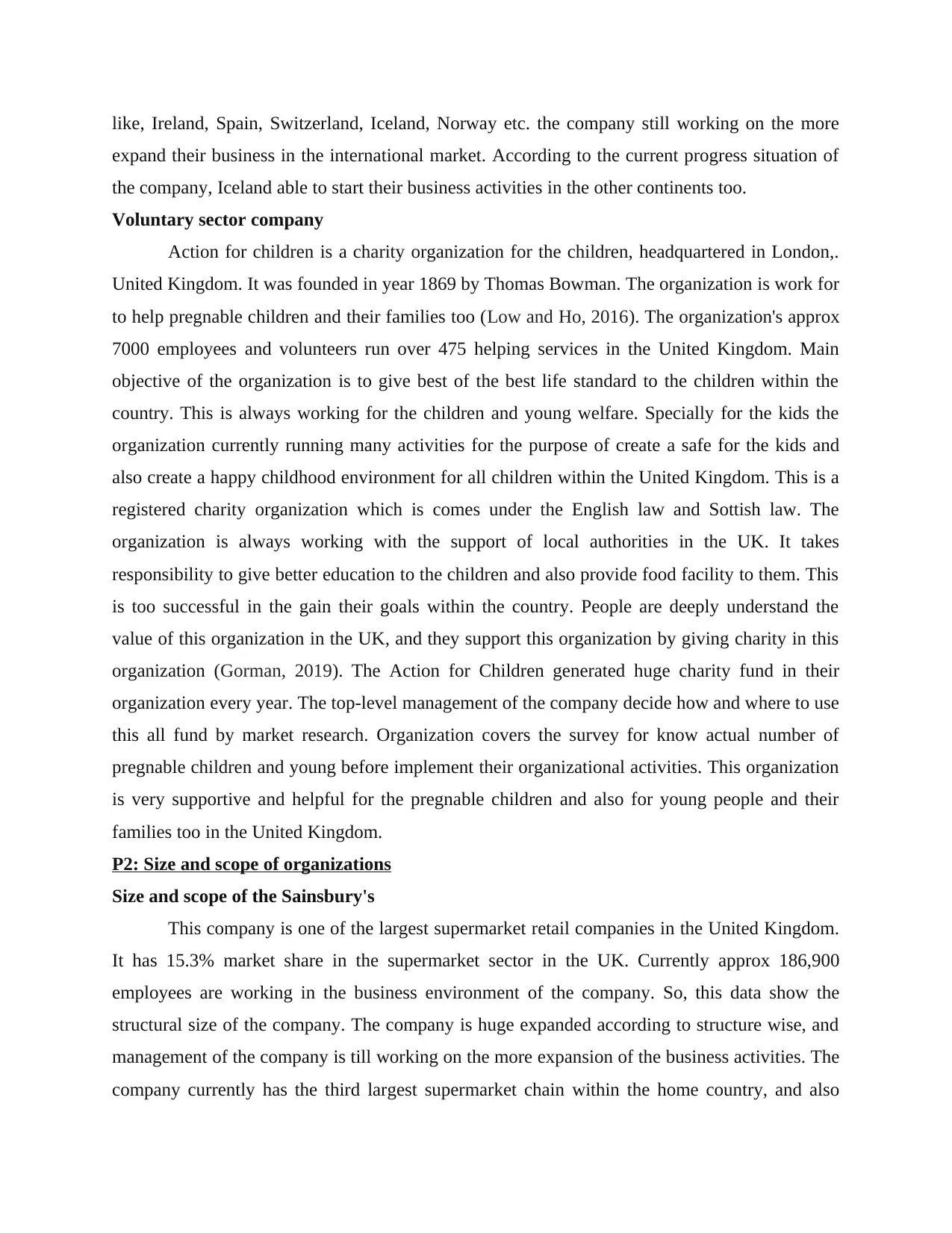
like, Ireland, Spain, Switzerland, Iceland, Norway etc. the company still working on the more
expand their business in the international market. According to the current progress situation of
the company, Iceland able to start their business activities in the other continents too.
Voluntary sector company
Action for children is a charity organization for the children, headquartered in London,.
United Kingdom. It was founded in year 1869 by Thomas Bowman. The organization is work for
to help pregnable children and their families too (Low and Ho, 2016). The organization's approx
7000 employees and volunteers run over 475 helping services in the United Kingdom. Main
objective of the organization is to give best of the best life standard to the children within the
country. This is always working for the children and young welfare. Specially for the kids the
organization currently running many activities for the purpose of create a safe for the kids and
also create a happy childhood environment for all children within the United Kingdom. This is a
registered charity organization which is comes under the English law and Sottish law. The
organization is always working with the support of local authorities in the UK. It takes
responsibility to give better education to the children and also provide food facility to them. This
is too successful in the gain their goals within the country. People are deeply understand the
value of this organization in the UK, and they support this organization by giving charity in this
organization (Gorman, 2019). The Action for Children generated huge charity fund in their
organization every year. The top-level management of the company decide how and where to use
this all fund by market research. Organization covers the survey for know actual number of
pregnable children and young before implement their organizational activities. This organization
is very supportive and helpful for the pregnable children and also for young people and their
families too in the United Kingdom.
P2: Size and scope of organizations
Size and scope of the Sainsbury's
This company is one of the largest supermarket retail companies in the United Kingdom.
It has 15.3% market share in the supermarket sector in the UK. Currently approx 186,900
employees are working in the business environment of the company. So, this data show the
structural size of the company. The company is huge expanded according to structure wise, and
management of the company is till working on the more expansion of the business activities. The
company currently has the third largest supermarket chain within the home country, and also
expand their business in the international market. According to the current progress situation of
the company, Iceland able to start their business activities in the other continents too.
Voluntary sector company
Action for children is a charity organization for the children, headquartered in London,.
United Kingdom. It was founded in year 1869 by Thomas Bowman. The organization is work for
to help pregnable children and their families too (Low and Ho, 2016). The organization's approx
7000 employees and volunteers run over 475 helping services in the United Kingdom. Main
objective of the organization is to give best of the best life standard to the children within the
country. This is always working for the children and young welfare. Specially for the kids the
organization currently running many activities for the purpose of create a safe for the kids and
also create a happy childhood environment for all children within the United Kingdom. This is a
registered charity organization which is comes under the English law and Sottish law. The
organization is always working with the support of local authorities in the UK. It takes
responsibility to give better education to the children and also provide food facility to them. This
is too successful in the gain their goals within the country. People are deeply understand the
value of this organization in the UK, and they support this organization by giving charity in this
organization (Gorman, 2019). The Action for Children generated huge charity fund in their
organization every year. The top-level management of the company decide how and where to use
this all fund by market research. Organization covers the survey for know actual number of
pregnable children and young before implement their organizational activities. This organization
is very supportive and helpful for the pregnable children and also for young people and their
families too in the United Kingdom.
P2: Size and scope of organizations
Size and scope of the Sainsbury's
This company is one of the largest supermarket retail companies in the United Kingdom.
It has 15.3% market share in the supermarket sector in the UK. Currently approx 186,900
employees are working in the business environment of the company. So, this data show the
structural size of the company. The company is huge expanded according to structure wise, and
management of the company is till working on the more expansion of the business activities. The
company currently has the third largest supermarket chain within the home country, and also
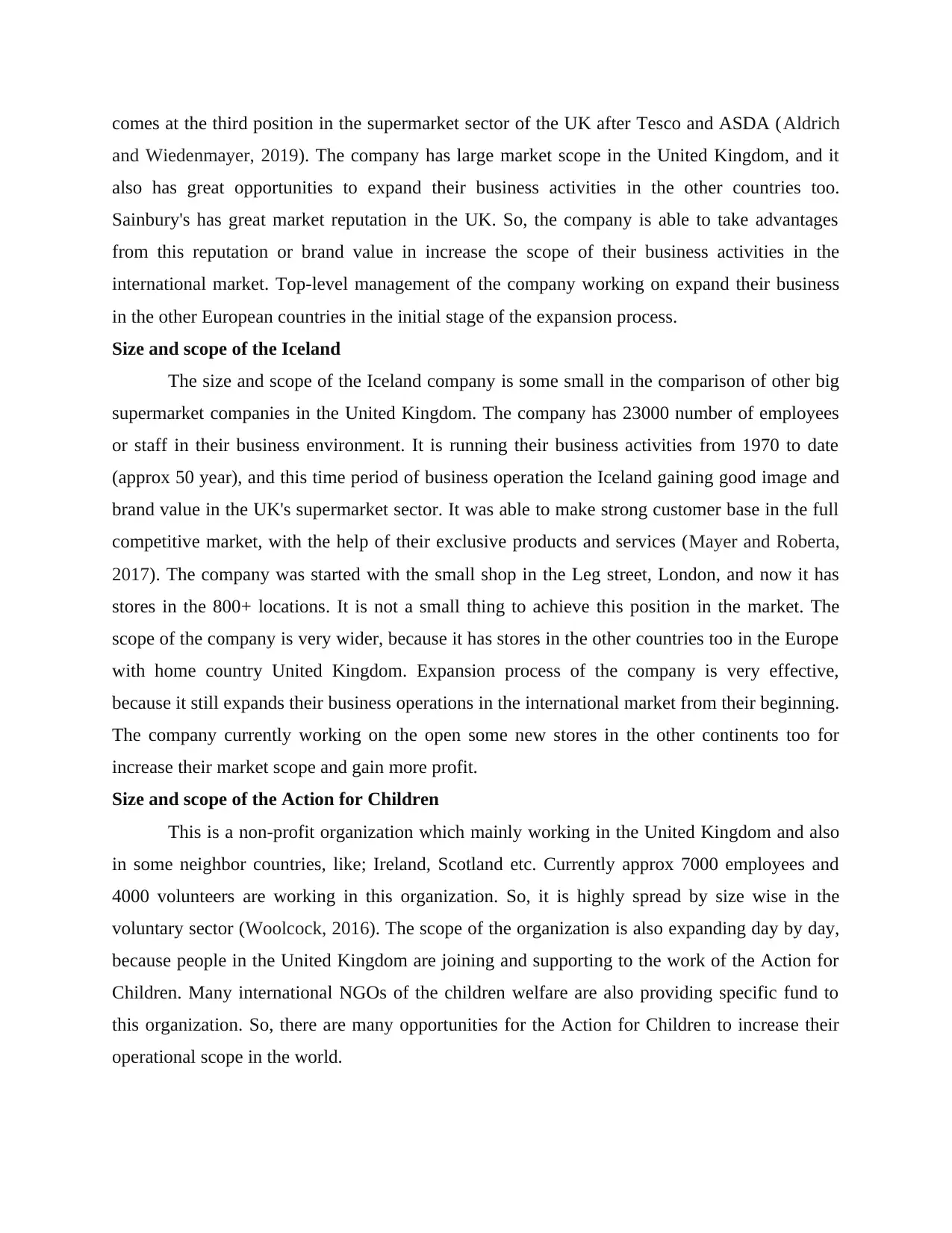
comes at the third position in the supermarket sector of the UK after Tesco and ASDA (Aldrich
and Wiedenmayer, 2019). The company has large market scope in the United Kingdom, and it
also has great opportunities to expand their business activities in the other countries too.
Sainbury's has great market reputation in the UK. So, the company is able to take advantages
from this reputation or brand value in increase the scope of their business activities in the
international market. Top-level management of the company working on expand their business
in the other European countries in the initial stage of the expansion process.
Size and scope of the Iceland
The size and scope of the Iceland company is some small in the comparison of other big
supermarket companies in the United Kingdom. The company has 23000 number of employees
or staff in their business environment. It is running their business activities from 1970 to date
(approx 50 year), and this time period of business operation the Iceland gaining good image and
brand value in the UK's supermarket sector. It was able to make strong customer base in the full
competitive market, with the help of their exclusive products and services (Mayer and Roberta,
2017). The company was started with the small shop in the Leg street, London, and now it has
stores in the 800+ locations. It is not a small thing to achieve this position in the market. The
scope of the company is very wider, because it has stores in the other countries too in the Europe
with home country United Kingdom. Expansion process of the company is very effective,
because it still expands their business operations in the international market from their beginning.
The company currently working on the open some new stores in the other continents too for
increase their market scope and gain more profit.
Size and scope of the Action for Children
This is a non-profit organization which mainly working in the United Kingdom and also
in some neighbor countries, like; Ireland, Scotland etc. Currently approx 7000 employees and
4000 volunteers are working in this organization. So, it is highly spread by size wise in the
voluntary sector (Woolcock, 2016). The scope of the organization is also expanding day by day,
because people in the United Kingdom are joining and supporting to the work of the Action for
Children. Many international NGOs of the children welfare are also providing specific fund to
this organization. So, there are many opportunities for the Action for Children to increase their
operational scope in the world.
and Wiedenmayer, 2019). The company has large market scope in the United Kingdom, and it
also has great opportunities to expand their business activities in the other countries too.
Sainbury's has great market reputation in the UK. So, the company is able to take advantages
from this reputation or brand value in increase the scope of their business activities in the
international market. Top-level management of the company working on expand their business
in the other European countries in the initial stage of the expansion process.
Size and scope of the Iceland
The size and scope of the Iceland company is some small in the comparison of other big
supermarket companies in the United Kingdom. The company has 23000 number of employees
or staff in their business environment. It is running their business activities from 1970 to date
(approx 50 year), and this time period of business operation the Iceland gaining good image and
brand value in the UK's supermarket sector. It was able to make strong customer base in the full
competitive market, with the help of their exclusive products and services (Mayer and Roberta,
2017). The company was started with the small shop in the Leg street, London, and now it has
stores in the 800+ locations. It is not a small thing to achieve this position in the market. The
scope of the company is very wider, because it has stores in the other countries too in the Europe
with home country United Kingdom. Expansion process of the company is very effective,
because it still expands their business operations in the international market from their beginning.
The company currently working on the open some new stores in the other continents too for
increase their market scope and gain more profit.
Size and scope of the Action for Children
This is a non-profit organization which mainly working in the United Kingdom and also
in some neighbor countries, like; Ireland, Scotland etc. Currently approx 7000 employees and
4000 volunteers are working in this organization. So, it is highly spread by size wise in the
voluntary sector (Woolcock, 2016). The scope of the organization is also expanding day by day,
because people in the United Kingdom are joining and supporting to the work of the Action for
Children. Many international NGOs of the children welfare are also providing specific fund to
this organization. So, there are many opportunities for the Action for Children to increase their
operational scope in the world.
⊘ This is a preview!⊘
Do you want full access?
Subscribe today to unlock all pages.

Trusted by 1+ million students worldwide
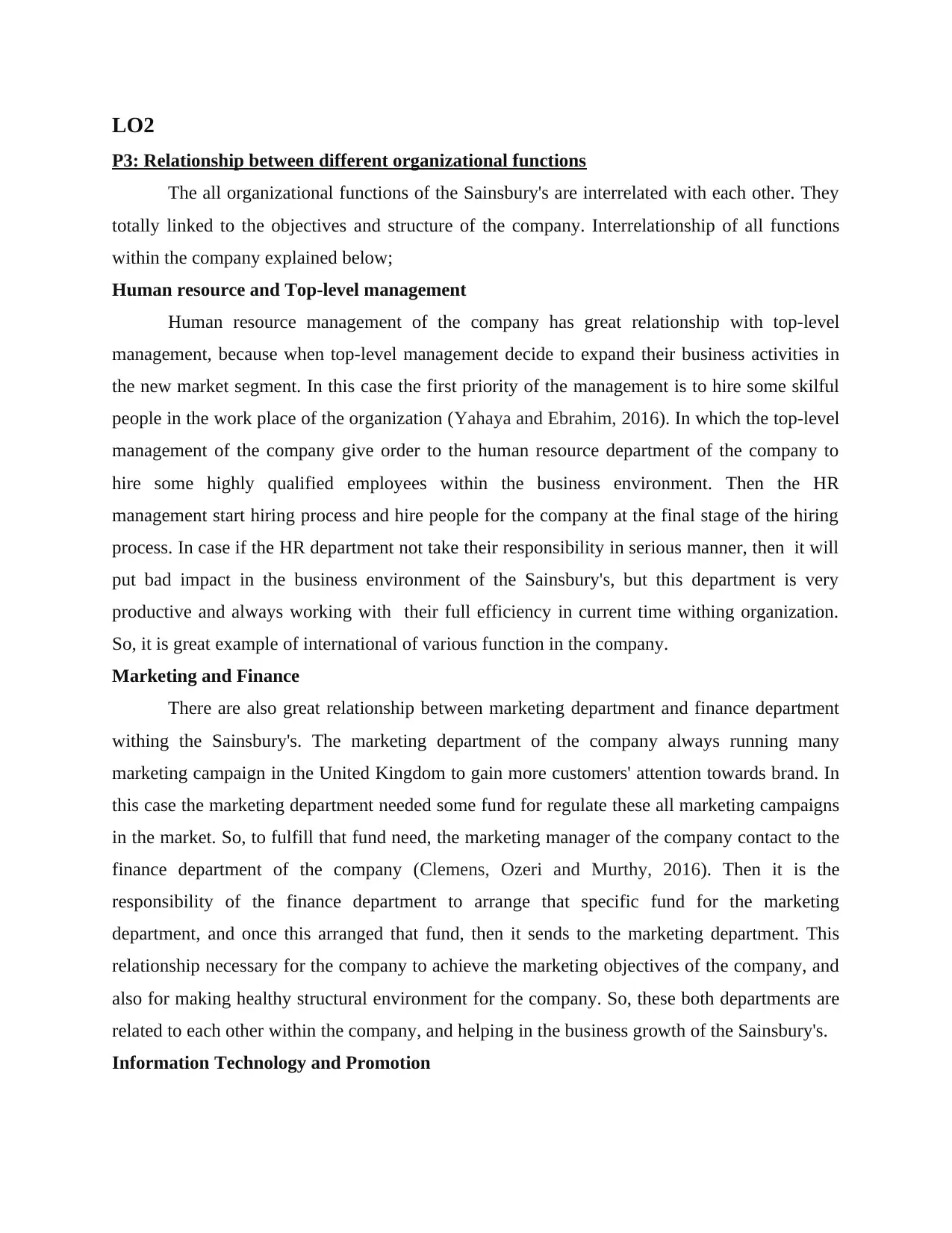
LO2
P3: Relationship between different organizational functions
The all organizational functions of the Sainsbury's are interrelated with each other. They
totally linked to the objectives and structure of the company. Interrelationship of all functions
within the company explained below;
Human resource and Top-level management
Human resource management of the company has great relationship with top-level
management, because when top-level management decide to expand their business activities in
the new market segment. In this case the first priority of the management is to hire some skilful
people in the work place of the organization (Yahaya and Ebrahim, 2016). In which the top-level
management of the company give order to the human resource department of the company to
hire some highly qualified employees within the business environment. Then the HR
management start hiring process and hire people for the company at the final stage of the hiring
process. In case if the HR department not take their responsibility in serious manner, then it will
put bad impact in the business environment of the Sainsbury's, but this department is very
productive and always working with their full efficiency in current time withing organization.
So, it is great example of international of various function in the company.
Marketing and Finance
There are also great relationship between marketing department and finance department
withing the Sainsbury's. The marketing department of the company always running many
marketing campaign in the United Kingdom to gain more customers' attention towards brand. In
this case the marketing department needed some fund for regulate these all marketing campaigns
in the market. So, to fulfill that fund need, the marketing manager of the company contact to the
finance department of the company (Clemens, Ozeri and Murthy, 2016). Then it is the
responsibility of the finance department to arrange that specific fund for the marketing
department, and once this arranged that fund, then it sends to the marketing department. This
relationship necessary for the company to achieve the marketing objectives of the company, and
also for making healthy structural environment for the company. So, these both departments are
related to each other within the company, and helping in the business growth of the Sainsbury's.
Information Technology and Promotion
P3: Relationship between different organizational functions
The all organizational functions of the Sainsbury's are interrelated with each other. They
totally linked to the objectives and structure of the company. Interrelationship of all functions
within the company explained below;
Human resource and Top-level management
Human resource management of the company has great relationship with top-level
management, because when top-level management decide to expand their business activities in
the new market segment. In this case the first priority of the management is to hire some skilful
people in the work place of the organization (Yahaya and Ebrahim, 2016). In which the top-level
management of the company give order to the human resource department of the company to
hire some highly qualified employees within the business environment. Then the HR
management start hiring process and hire people for the company at the final stage of the hiring
process. In case if the HR department not take their responsibility in serious manner, then it will
put bad impact in the business environment of the Sainsbury's, but this department is very
productive and always working with their full efficiency in current time withing organization.
So, it is great example of international of various function in the company.
Marketing and Finance
There are also great relationship between marketing department and finance department
withing the Sainsbury's. The marketing department of the company always running many
marketing campaign in the United Kingdom to gain more customers' attention towards brand. In
this case the marketing department needed some fund for regulate these all marketing campaigns
in the market. So, to fulfill that fund need, the marketing manager of the company contact to the
finance department of the company (Clemens, Ozeri and Murthy, 2016). Then it is the
responsibility of the finance department to arrange that specific fund for the marketing
department, and once this arranged that fund, then it sends to the marketing department. This
relationship necessary for the company to achieve the marketing objectives of the company, and
also for making healthy structural environment for the company. So, these both departments are
related to each other within the company, and helping in the business growth of the Sainsbury's.
Information Technology and Promotion
Paraphrase This Document
Need a fresh take? Get an instant paraphrase of this document with our AI Paraphraser
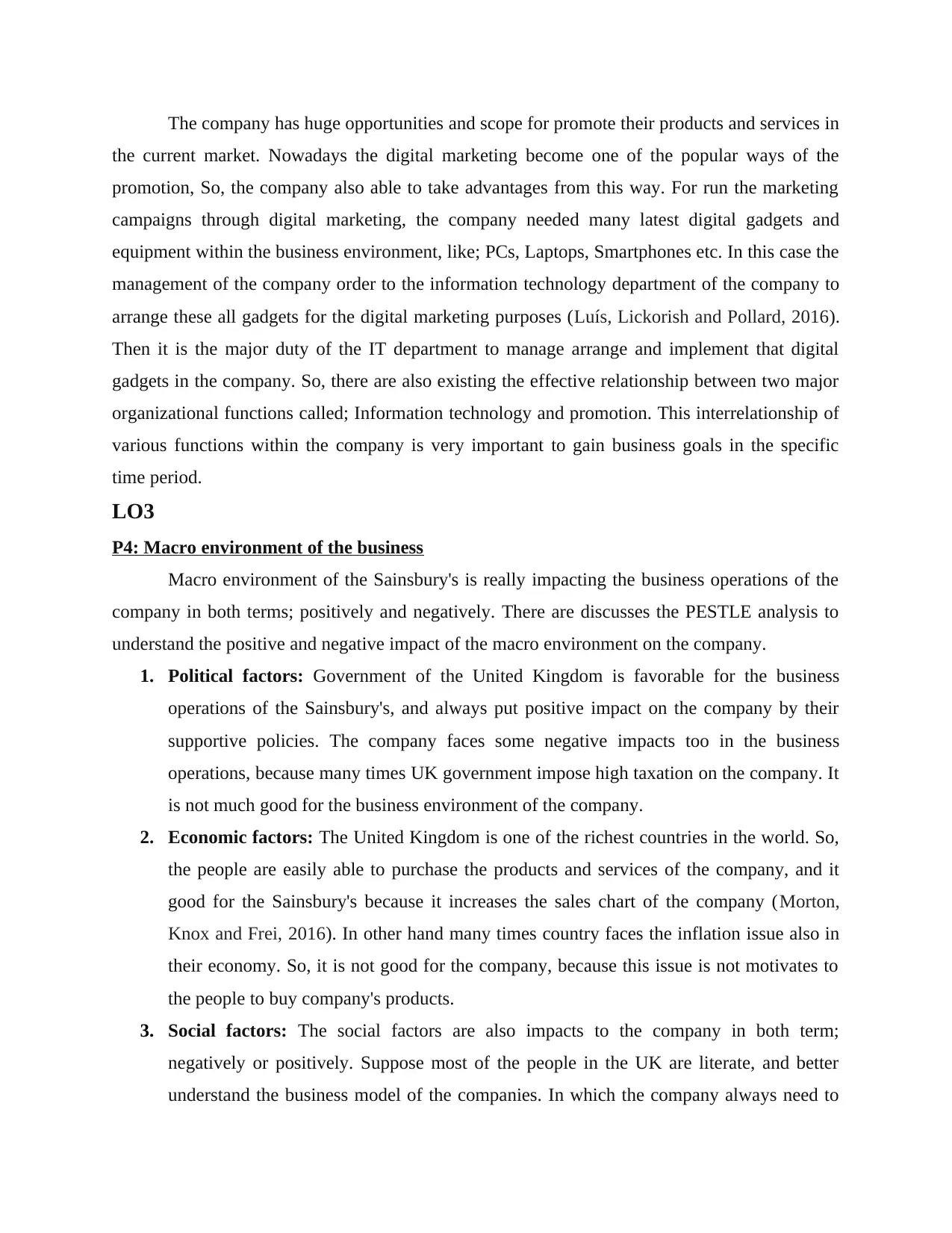
The company has huge opportunities and scope for promote their products and services in
the current market. Nowadays the digital marketing become one of the popular ways of the
promotion, So, the company also able to take advantages from this way. For run the marketing
campaigns through digital marketing, the company needed many latest digital gadgets and
equipment within the business environment, like; PCs, Laptops, Smartphones etc. In this case the
management of the company order to the information technology department of the company to
arrange these all gadgets for the digital marketing purposes (Luís, Lickorish and Pollard, 2016).
Then it is the major duty of the IT department to manage arrange and implement that digital
gadgets in the company. So, there are also existing the effective relationship between two major
organizational functions called; Information technology and promotion. This interrelationship of
various functions within the company is very important to gain business goals in the specific
time period.
LO3
P4: Macro environment of the business
Macro environment of the Sainsbury's is really impacting the business operations of the
company in both terms; positively and negatively. There are discusses the PESTLE analysis to
understand the positive and negative impact of the macro environment on the company.
1. Political factors: Government of the United Kingdom is favorable for the business
operations of the Sainsbury's, and always put positive impact on the company by their
supportive policies. The company faces some negative impacts too in the business
operations, because many times UK government impose high taxation on the company. It
is not much good for the business environment of the company.
2. Economic factors: The United Kingdom is one of the richest countries in the world. So,
the people are easily able to purchase the products and services of the company, and it
good for the Sainsbury's because it increases the sales chart of the company (Morton,
Knox and Frei, 2016). In other hand many times country faces the inflation issue also in
their economy. So, it is not good for the company, because this issue is not motivates to
the people to buy company's products.
3. Social factors: The social factors are also impacts to the company in both term;
negatively or positively. Suppose most of the people in the UK are literate, and better
understand the business model of the companies. In which the company always need to
the current market. Nowadays the digital marketing become one of the popular ways of the
promotion, So, the company also able to take advantages from this way. For run the marketing
campaigns through digital marketing, the company needed many latest digital gadgets and
equipment within the business environment, like; PCs, Laptops, Smartphones etc. In this case the
management of the company order to the information technology department of the company to
arrange these all gadgets for the digital marketing purposes (Luís, Lickorish and Pollard, 2016).
Then it is the major duty of the IT department to manage arrange and implement that digital
gadgets in the company. So, there are also existing the effective relationship between two major
organizational functions called; Information technology and promotion. This interrelationship of
various functions within the company is very important to gain business goals in the specific
time period.
LO3
P4: Macro environment of the business
Macro environment of the Sainsbury's is really impacting the business operations of the
company in both terms; positively and negatively. There are discusses the PESTLE analysis to
understand the positive and negative impact of the macro environment on the company.
1. Political factors: Government of the United Kingdom is favorable for the business
operations of the Sainsbury's, and always put positive impact on the company by their
supportive policies. The company faces some negative impacts too in the business
operations, because many times UK government impose high taxation on the company. It
is not much good for the business environment of the company.
2. Economic factors: The United Kingdom is one of the richest countries in the world. So,
the people are easily able to purchase the products and services of the company, and it
good for the Sainsbury's because it increases the sales chart of the company (Morton,
Knox and Frei, 2016). In other hand many times country faces the inflation issue also in
their economy. So, it is not good for the company, because this issue is not motivates to
the people to buy company's products.
3. Social factors: The social factors are also impacts to the company in both term;
negatively or positively. Suppose most of the people in the UK are literate, and better
understand the business model of the companies. In which the company always need to
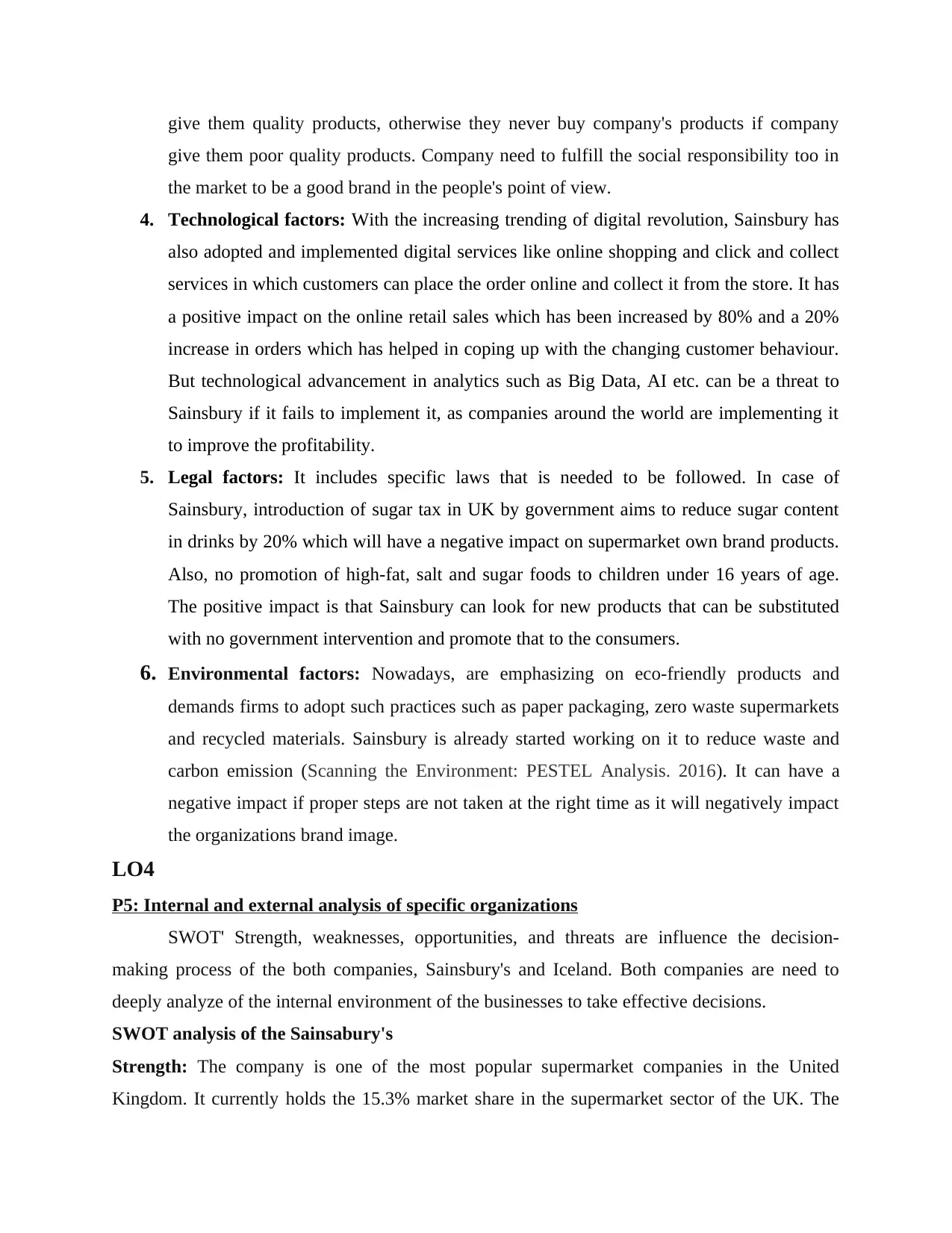
give them quality products, otherwise they never buy company's products if company
give them poor quality products. Company need to fulfill the social responsibility too in
the market to be a good brand in the people's point of view.
4. Technological factors: With the increasing trending of digital revolution, Sainsbury has
also adopted and implemented digital services like online shopping and click and collect
services in which customers can place the order online and collect it from the store. It has
a positive impact on the online retail sales which has been increased by 80% and a 20%
increase in orders which has helped in coping up with the changing customer behaviour.
But technological advancement in analytics such as Big Data, AI etc. can be a threat to
Sainsbury if it fails to implement it, as companies around the world are implementing it
to improve the profitability.
5. Legal factors: It includes specific laws that is needed to be followed. In case of
Sainsbury, introduction of sugar tax in UK by government aims to reduce sugar content
in drinks by 20% which will have a negative impact on supermarket own brand products.
Also, no promotion of high-fat, salt and sugar foods to children under 16 years of age.
The positive impact is that Sainsbury can look for new products that can be substituted
with no government intervention and promote that to the consumers.
6. Environmental factors: Nowadays, are emphasizing on eco-friendly products and
demands firms to adopt such practices such as paper packaging, zero waste supermarkets
and recycled materials. Sainsbury is already started working on it to reduce waste and
carbon emission (Scanning the Environment: PESTEL Analysis. 2016). It can have a
negative impact if proper steps are not taken at the right time as it will negatively impact
the organizations brand image.
LO4
P5: Internal and external analysis of specific organizations
SWOT' Strength, weaknesses, opportunities, and threats are influence the decision-
making process of the both companies, Sainsbury's and Iceland. Both companies are need to
deeply analyze of the internal environment of the businesses to take effective decisions.
SWOT analysis of the Sainsabury's
Strength: The company is one of the most popular supermarket companies in the United
Kingdom. It currently holds the 15.3% market share in the supermarket sector of the UK. The
give them poor quality products. Company need to fulfill the social responsibility too in
the market to be a good brand in the people's point of view.
4. Technological factors: With the increasing trending of digital revolution, Sainsbury has
also adopted and implemented digital services like online shopping and click and collect
services in which customers can place the order online and collect it from the store. It has
a positive impact on the online retail sales which has been increased by 80% and a 20%
increase in orders which has helped in coping up with the changing customer behaviour.
But technological advancement in analytics such as Big Data, AI etc. can be a threat to
Sainsbury if it fails to implement it, as companies around the world are implementing it
to improve the profitability.
5. Legal factors: It includes specific laws that is needed to be followed. In case of
Sainsbury, introduction of sugar tax in UK by government aims to reduce sugar content
in drinks by 20% which will have a negative impact on supermarket own brand products.
Also, no promotion of high-fat, salt and sugar foods to children under 16 years of age.
The positive impact is that Sainsbury can look for new products that can be substituted
with no government intervention and promote that to the consumers.
6. Environmental factors: Nowadays, are emphasizing on eco-friendly products and
demands firms to adopt such practices such as paper packaging, zero waste supermarkets
and recycled materials. Sainsbury is already started working on it to reduce waste and
carbon emission (Scanning the Environment: PESTEL Analysis. 2016). It can have a
negative impact if proper steps are not taken at the right time as it will negatively impact
the organizations brand image.
LO4
P5: Internal and external analysis of specific organizations
SWOT' Strength, weaknesses, opportunities, and threats are influence the decision-
making process of the both companies, Sainsbury's and Iceland. Both companies are need to
deeply analyze of the internal environment of the businesses to take effective decisions.
SWOT analysis of the Sainsabury's
Strength: The company is one of the most popular supermarket companies in the United
Kingdom. It currently holds the 15.3% market share in the supermarket sector of the UK. The
⊘ This is a preview!⊘
Do you want full access?
Subscribe today to unlock all pages.

Trusted by 1+ million students worldwide
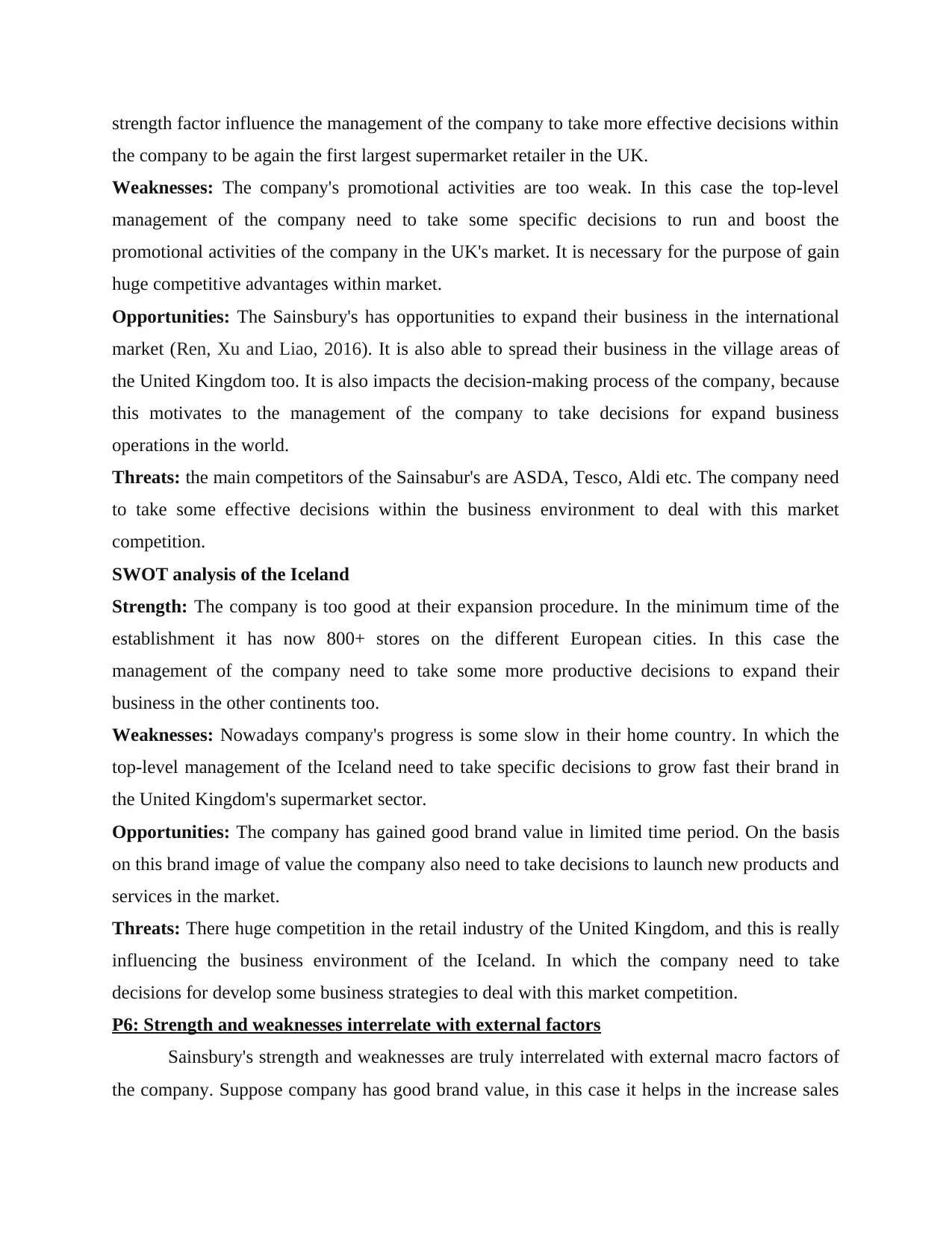
strength factor influence the management of the company to take more effective decisions within
the company to be again the first largest supermarket retailer in the UK.
Weaknesses: The company's promotional activities are too weak. In this case the top-level
management of the company need to take some specific decisions to run and boost the
promotional activities of the company in the UK's market. It is necessary for the purpose of gain
huge competitive advantages within market.
Opportunities: The Sainsbury's has opportunities to expand their business in the international
market (Ren, Xu and Liao, 2016). It is also able to spread their business in the village areas of
the United Kingdom too. It is also impacts the decision-making process of the company, because
this motivates to the management of the company to take decisions for expand business
operations in the world.
Threats: the main competitors of the Sainsabur's are ASDA, Tesco, Aldi etc. The company need
to take some effective decisions within the business environment to deal with this market
competition.
SWOT analysis of the Iceland
Strength: The company is too good at their expansion procedure. In the minimum time of the
establishment it has now 800+ stores on the different European cities. In this case the
management of the company need to take some more productive decisions to expand their
business in the other continents too.
Weaknesses: Nowadays company's progress is some slow in their home country. In which the
top-level management of the Iceland need to take specific decisions to grow fast their brand in
the United Kingdom's supermarket sector.
Opportunities: The company has gained good brand value in limited time period. On the basis
on this brand image of value the company also need to take decisions to launch new products and
services in the market.
Threats: There huge competition in the retail industry of the United Kingdom, and this is really
influencing the business environment of the Iceland. In which the company need to take
decisions for develop some business strategies to deal with this market competition.
P6: Strength and weaknesses interrelate with external factors
Sainsbury's strength and weaknesses are truly interrelated with external macro factors of
the company. Suppose company has good brand value, in this case it helps in the increase sales
the company to be again the first largest supermarket retailer in the UK.
Weaknesses: The company's promotional activities are too weak. In this case the top-level
management of the company need to take some specific decisions to run and boost the
promotional activities of the company in the UK's market. It is necessary for the purpose of gain
huge competitive advantages within market.
Opportunities: The Sainsbury's has opportunities to expand their business in the international
market (Ren, Xu and Liao, 2016). It is also able to spread their business in the village areas of
the United Kingdom too. It is also impacts the decision-making process of the company, because
this motivates to the management of the company to take decisions for expand business
operations in the world.
Threats: the main competitors of the Sainsabur's are ASDA, Tesco, Aldi etc. The company need
to take some effective decisions within the business environment to deal with this market
competition.
SWOT analysis of the Iceland
Strength: The company is too good at their expansion procedure. In the minimum time of the
establishment it has now 800+ stores on the different European cities. In this case the
management of the company need to take some more productive decisions to expand their
business in the other continents too.
Weaknesses: Nowadays company's progress is some slow in their home country. In which the
top-level management of the Iceland need to take specific decisions to grow fast their brand in
the United Kingdom's supermarket sector.
Opportunities: The company has gained good brand value in limited time period. On the basis
on this brand image of value the company also need to take decisions to launch new products and
services in the market.
Threats: There huge competition in the retail industry of the United Kingdom, and this is really
influencing the business environment of the Iceland. In which the company need to take
decisions for develop some business strategies to deal with this market competition.
P6: Strength and weaknesses interrelate with external factors
Sainsbury's strength and weaknesses are truly interrelated with external macro factors of
the company. Suppose company has good brand value, in this case it helps in the increase sales
Paraphrase This Document
Need a fresh take? Get an instant paraphrase of this document with our AI Paraphraser
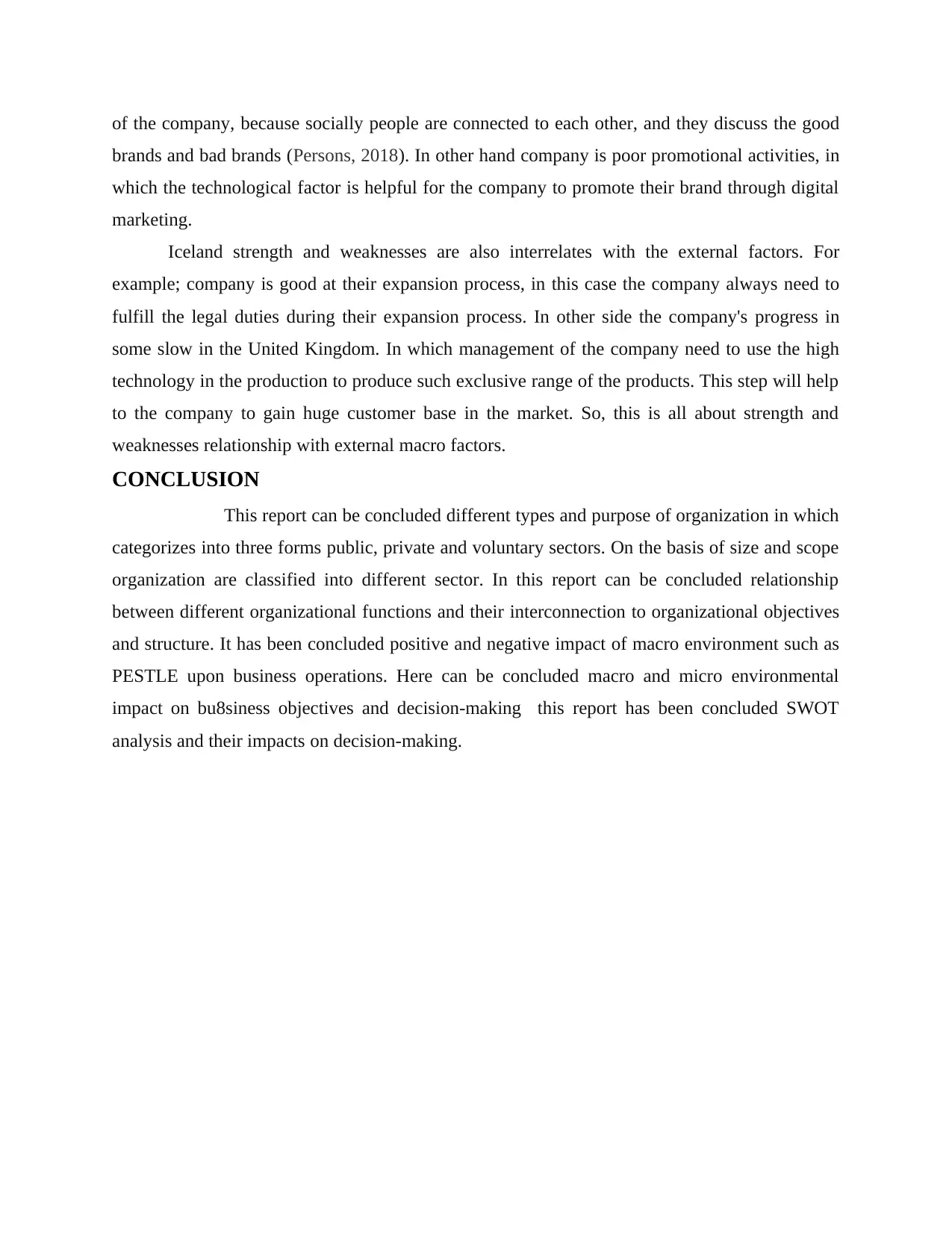
of the company, because socially people are connected to each other, and they discuss the good
brands and bad brands (Persons, 2018). In other hand company is poor promotional activities, in
which the technological factor is helpful for the company to promote their brand through digital
marketing.
Iceland strength and weaknesses are also interrelates with the external factors. For
example; company is good at their expansion process, in this case the company always need to
fulfill the legal duties during their expansion process. In other side the company's progress in
some slow in the United Kingdom. In which management of the company need to use the high
technology in the production to produce such exclusive range of the products. This step will help
to the company to gain huge customer base in the market. So, this is all about strength and
weaknesses relationship with external macro factors.
CONCLUSION
This report can be concluded different types and purpose of organization in which
categorizes into three forms public, private and voluntary sectors. On the basis of size and scope
organization are classified into different sector. In this report can be concluded relationship
between different organizational functions and their interconnection to organizational objectives
and structure. It has been concluded positive and negative impact of macro environment such as
PESTLE upon business operations. Here can be concluded macro and micro environmental
impact on bu8siness objectives and decision-making this report has been concluded SWOT
analysis and their impacts on decision-making.
brands and bad brands (Persons, 2018). In other hand company is poor promotional activities, in
which the technological factor is helpful for the company to promote their brand through digital
marketing.
Iceland strength and weaknesses are also interrelates with the external factors. For
example; company is good at their expansion process, in this case the company always need to
fulfill the legal duties during their expansion process. In other side the company's progress in
some slow in the United Kingdom. In which management of the company need to use the high
technology in the production to produce such exclusive range of the products. This step will help
to the company to gain huge customer base in the market. So, this is all about strength and
weaknesses relationship with external macro factors.
CONCLUSION
This report can be concluded different types and purpose of organization in which
categorizes into three forms public, private and voluntary sectors. On the basis of size and scope
organization are classified into different sector. In this report can be concluded relationship
between different organizational functions and their interconnection to organizational objectives
and structure. It has been concluded positive and negative impact of macro environment such as
PESTLE upon business operations. Here can be concluded macro and micro environmental
impact on bu8siness objectives and decision-making this report has been concluded SWOT
analysis and their impacts on decision-making.
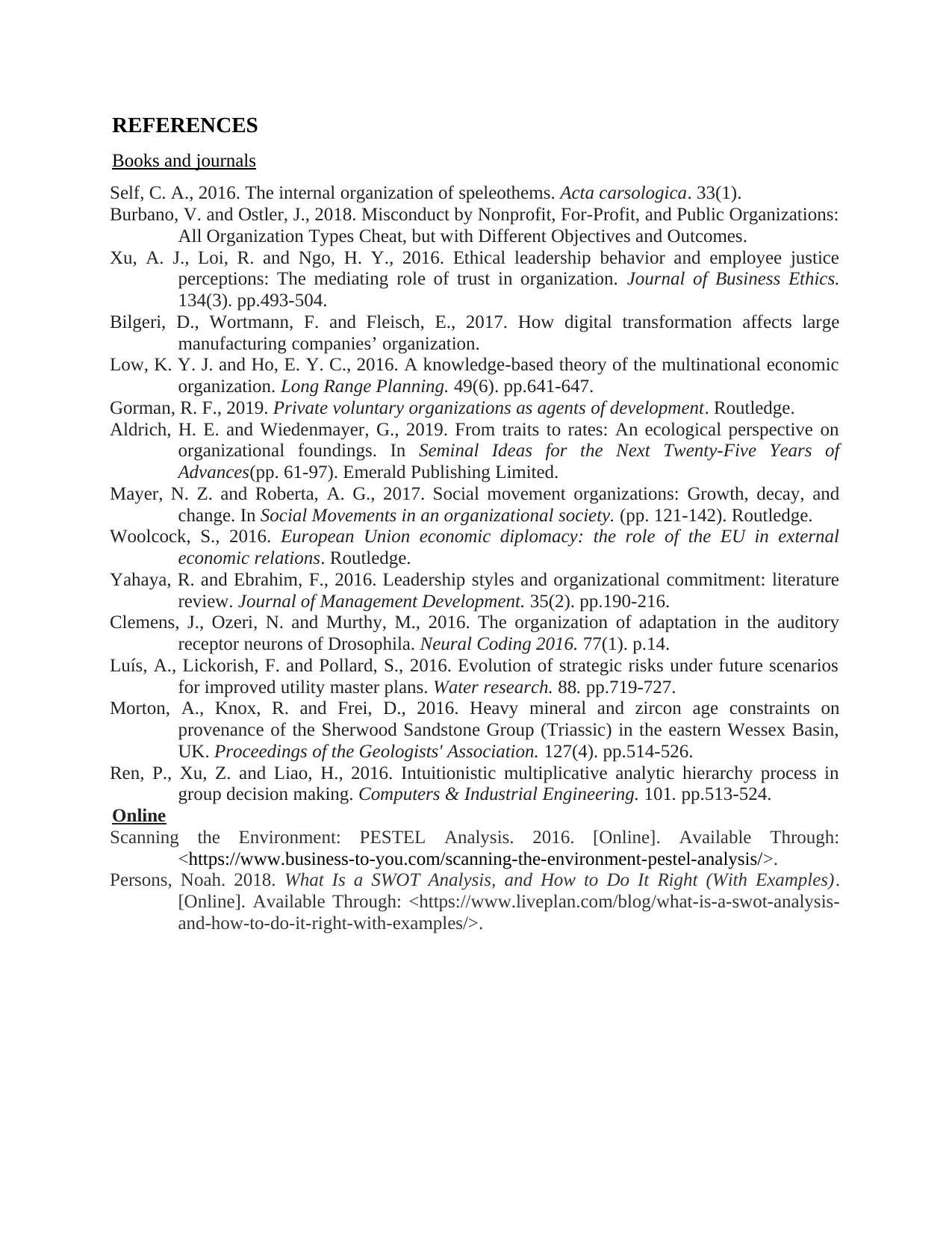
REFERENCES
Books and journals
Self, C. A., 2016. The internal organization of speleothems. Acta carsologica. 33(1).
Burbano, V. and Ostler, J., 2018. Misconduct by Nonprofit, For-Profit, and Public Organizations:
All Organization Types Cheat, but with Different Objectives and Outcomes.
Xu, A. J., Loi, R. and Ngo, H. Y., 2016. Ethical leadership behavior and employee justice
perceptions: The mediating role of trust in organization. Journal of Business Ethics.
134(3). pp.493-504.
Bilgeri, D., Wortmann, F. and Fleisch, E., 2017. How digital transformation affects large
manufacturing companies’ organization.
Low, K. Y. J. and Ho, E. Y. C., 2016. A knowledge-based theory of the multinational economic
organization. Long Range Planning. 49(6). pp.641-647.
Gorman, R. F., 2019. Private voluntary organizations as agents of development. Routledge.
Aldrich, H. E. and Wiedenmayer, G., 2019. From traits to rates: An ecological perspective on
organizational foundings. In Seminal Ideas for the Next Twenty-Five Years of
Advances(pp. 61-97). Emerald Publishing Limited.
Mayer, N. Z. and Roberta, A. G., 2017. Social movement organizations: Growth, decay, and
change. In Social Movements in an organizational society. (pp. 121-142). Routledge.
Woolcock, S., 2016. European Union economic diplomacy: the role of the EU in external
economic relations. Routledge.
Yahaya, R. and Ebrahim, F., 2016. Leadership styles and organizational commitment: literature
review. Journal of Management Development. 35(2). pp.190-216.
Clemens, J., Ozeri, N. and Murthy, M., 2016. The organization of adaptation in the auditory
receptor neurons of Drosophila. Neural Coding 2016. 77(1). p.14.
Luís, A., Lickorish, F. and Pollard, S., 2016. Evolution of strategic risks under future scenarios
for improved utility master plans. Water research. 88. pp.719-727.
Morton, A., Knox, R. and Frei, D., 2016. Heavy mineral and zircon age constraints on
provenance of the Sherwood Sandstone Group (Triassic) in the eastern Wessex Basin,
UK. Proceedings of the Geologists' Association. 127(4). pp.514-526.
Ren, P., Xu, Z. and Liao, H., 2016. Intuitionistic multiplicative analytic hierarchy process in
group decision making. Computers & Industrial Engineering. 101. pp.513-524.
Online
Scanning the Environment: PESTEL Analysis. 2016. [Online]. Available Through:
<https://www.business-to-you.com/scanning-the-environment-pestel-analysis/>.
Persons, Noah. 2018. What Is a SWOT Analysis, and How to Do It Right (With Examples).
[Online]. Available Through: <https://www.liveplan.com/blog/what-is-a-swot-analysis-
and-how-to-do-it-right-with-examples/>.
Books and journals
Self, C. A., 2016. The internal organization of speleothems. Acta carsologica. 33(1).
Burbano, V. and Ostler, J., 2018. Misconduct by Nonprofit, For-Profit, and Public Organizations:
All Organization Types Cheat, but with Different Objectives and Outcomes.
Xu, A. J., Loi, R. and Ngo, H. Y., 2016. Ethical leadership behavior and employee justice
perceptions: The mediating role of trust in organization. Journal of Business Ethics.
134(3). pp.493-504.
Bilgeri, D., Wortmann, F. and Fleisch, E., 2017. How digital transformation affects large
manufacturing companies’ organization.
Low, K. Y. J. and Ho, E. Y. C., 2016. A knowledge-based theory of the multinational economic
organization. Long Range Planning. 49(6). pp.641-647.
Gorman, R. F., 2019. Private voluntary organizations as agents of development. Routledge.
Aldrich, H. E. and Wiedenmayer, G., 2019. From traits to rates: An ecological perspective on
organizational foundings. In Seminal Ideas for the Next Twenty-Five Years of
Advances(pp. 61-97). Emerald Publishing Limited.
Mayer, N. Z. and Roberta, A. G., 2017. Social movement organizations: Growth, decay, and
change. In Social Movements in an organizational society. (pp. 121-142). Routledge.
Woolcock, S., 2016. European Union economic diplomacy: the role of the EU in external
economic relations. Routledge.
Yahaya, R. and Ebrahim, F., 2016. Leadership styles and organizational commitment: literature
review. Journal of Management Development. 35(2). pp.190-216.
Clemens, J., Ozeri, N. and Murthy, M., 2016. The organization of adaptation in the auditory
receptor neurons of Drosophila. Neural Coding 2016. 77(1). p.14.
Luís, A., Lickorish, F. and Pollard, S., 2016. Evolution of strategic risks under future scenarios
for improved utility master plans. Water research. 88. pp.719-727.
Morton, A., Knox, R. and Frei, D., 2016. Heavy mineral and zircon age constraints on
provenance of the Sherwood Sandstone Group (Triassic) in the eastern Wessex Basin,
UK. Proceedings of the Geologists' Association. 127(4). pp.514-526.
Ren, P., Xu, Z. and Liao, H., 2016. Intuitionistic multiplicative analytic hierarchy process in
group decision making. Computers & Industrial Engineering. 101. pp.513-524.
Online
Scanning the Environment: PESTEL Analysis. 2016. [Online]. Available Through:
<https://www.business-to-you.com/scanning-the-environment-pestel-analysis/>.
Persons, Noah. 2018. What Is a SWOT Analysis, and How to Do It Right (With Examples).
[Online]. Available Through: <https://www.liveplan.com/blog/what-is-a-swot-analysis-
and-how-to-do-it-right-with-examples/>.
⊘ This is a preview!⊘
Do you want full access?
Subscribe today to unlock all pages.

Trusted by 1+ million students worldwide
1 out of 13
Related Documents
Your All-in-One AI-Powered Toolkit for Academic Success.
+13062052269
info@desklib.com
Available 24*7 on WhatsApp / Email
![[object Object]](/_next/static/media/star-bottom.7253800d.svg)
Unlock your academic potential
Copyright © 2020–2025 A2Z Services. All Rights Reserved. Developed and managed by ZUCOL.


